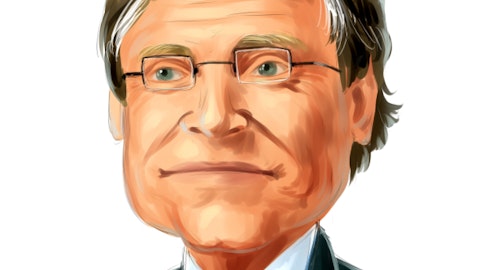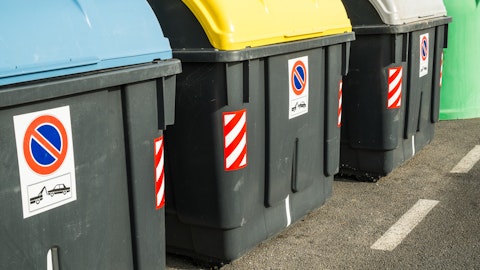That’s not part of our model. So this allowed us to achieve that. So it’s done a number of things for us currently and forward-looking.
Noah Kaye: Great color. And then on RNG, Mary Anne, you said the guide does not include any benefit from ITC tax credits in ‘24, that is just pure optionality if treasury were to finalize guidance in a way that is consistent with the law, meaning allowing companies to claim the credit on what is essentially the major pieces of equipment. What could that possibly do in terms of incremental cash tax benefits to the company? Is that something you’ve sized comfortable in sharing?
Mary Anne Whitney: Sure. Well, given the fact, Noah, that as you know, only a small percentage of our projects are – we will own outright in ‘24, it’s pretty nominal. It’s about $10 million in incremental benefit that we’d expect.
Noah Kaye: And on the full portfolio once it’s built out?
Mary Anne Whitney: Yes, that whole portfolio, I’m not in a position to give that yet. Just looking at what’s qualifying equipment and what the actual outlays are for the projects will loan.
Noah Kaye: Alright. We will stay tuned for that. Thank you very much.
Mary Anne Whitney: Yes, sure.
Operator: Our next question comes from Kevin Chiang from CIBC. Please go ahead with your question.
Kevin Chiang: Hi, thanks for taking my question. Maybe just on the – congratulations on closing on the secure deal. I know this came out through a Competition Bureau Tribunal. And my understanding is that Secure wasn’t necessarily running these Tervita assets to their full capabilities. Just wondering how that might change under your ownership. And the revenue guide you provided related to that acquisition is that the run-rate Secure was achieving? So any upside you’d see? Or is that the revenue you think you can achieve as you own these assets?
Ron Mittelstaedt: Okay. A couple of pieces there, Kevin. So first off, there were 29 assets required to be divested by the tribunal, of which 22 were operating at the time of close. And I would say they were operating at full throttle, Secure is a very good operator. and they had optimized the facility. So the 22 we’re running of the 29. And the guidance we have provided for ‘24 and Secure includes those 22 facilities. There are seven incremental facilities that we will be reopening over a period of time, perhaps some of those in ‘24, but certainly into ‘25. We’re looking at that right now. That is not in what we have guided, okay? And we would not make those assumptions that, that would be anything material but it certainly could be incremental to ‘25 and beyond. So that’s how I think you should think of what is in the guidance and what is available beyond that.
Kevin Chiang: That’s helpful. And then just maybe on to – congratulations again on winning those zones in New York. Obviously, there are a number of bidders that came up short here. I just wondered, does that create an M&A opportunity for you to maybe pick up assets in that market from haulers that might look at New York differently because they want fewer zones or maybe win any zones after the bidding process?
Ron Mittelstaedt: Well, I would say, Kevin, generally, the answer is yes to everything you said, but it is a complex situation. So remember that while this is a franchise area, there are three non-exclusive franchisees awarded to each zone. You certainly can acquire potentially acquire someone within zones you have or other zones. But first, you must get the city and the BIC, the Business Council’s approval of such and they have to determine what their comfort is on reducing competitors in a zone. And then that could add a third competitor back if it was an overlapping zone. So there are a number of complexities. There are also caps on how many zones one can own right now. So they have to decide their comfort level if someone goes beyond that cap or do they then have to divest another zone or trade it. So it’s a complex situation. But generally, I would say it improves our optionality and M&A opportunities in the city.
Kevin Chiang: Perfect. That’s all my questions. Congrats on a strong end to the year there.
Ron Mittelstaedt: Thank you very much.
Operator: Our next question comes from Bryan Burgmeier from Citi. Please go ahead with your question.
Bryan Burgmeier: Good morning. Thank you for taking the question. I think on the last call, you talked about wage growth kind of moderating to maybe 6%, 6.5% and maybe the exit rate for ‘23 being 5%, 5.5%. I’m just wondering are those still good numbers? Is there any view on what that wage growth can look like in ‘24? I’m just kind of be cognizant of kind of ongoing inflation, some changes in your portfolio versus that strong margin expansion that you did see 4Q?
Mary Anne Whitney: Sure. So with respect to wage growth, you’re right, we talked about in 2023 of the moderation from a starting point of about 8% coming into the year to the exit of about 6%, which is what we saw in Q4, I think, to one of your questions that it did get to that level. So as we think about continued moderation and the non-repeating of outsized increases or last year’s level of increases, we would think about further moderation. And as we talk about underlying solid waste margin expansion, one of the drivers being cost moderation as we move through the year. So I think about it, we saw 8% to 6% in 2023, 6% – maybe the rate of slowing down flows. And so maybe it’s 6% to 5% or sub-5 as we move through the year. That’s probably a realistic way to think about some of those cost pressures moderating specifically wages.
Bryan Burgmeier: Got it. Got it. Thanks for that detail. And can you just help size maybe the revenue impact from M&A in 1Q? I know the E&P deal closed mid-quarter, I am not sure if there is some seasonality to be mindful of. And then just a smaller item as you talked about Arrowhead maybe being slightly dilutive to margins at the beginning, do you think that kind of flips to a slight positive in ‘24, especially with this new, New York City business?
Mary Anne Whitney: Sure. So, with respect to the contribution from acquisitions in Q1 and how to think about that, about $65 million in Q1 and you should think about some seasonality as we head into Q2 even for the E&P business. So it’s a little different from the underlying business, what drives the timing there. But so I would have overall acquisitions ramping a little bit as we move through the year and then dropping down toward the end of the year just as we anniversary some coming online. But $65 million for Q1 is a good way to think about it.
Ron Mittelstaedt: And then with regard to Arrowhead, I would tell you that as we move throughout ‘24, you are correct, that initially because of the rail component of transportation in the model Arrowhead was nominally dilutive to margins. It will be accretive to margins by midyear as volumes continue to ramp there. And as disproportionate amount of those volumes are our internal volumes. So you have an elimination, an intercompany elimination, which raises the margin profile of the asset relative to volumes coming third-party, which dilutes the margin profile of the assets. So there is semantics there that are important on the margin.
Bryan Burgmeier: Got it. Thanks a lot. I will turn it over. Good luck on the quarter.
Ron Mittelstaedt: Thank you.
Mary Anne Whitney: Thank you.
Operator: Our next question comes from John Mazzoni from Wells Fargo. Please go ahead with your question.
John Mazzoni: Good morning. Congratulations on the strong results. Maybe ask it in a different way, could you talk to the competitive backdrop with your peers focusing more on sustainability projects and more about kind of what changes you’re expecting in terms of – kind of markets exiting ‘24, what you’ve seen – or exiting ‘23, excuse me, into ‘24. And has there been any uptake from kind of sponsors, I think private equity dry powder is kind of in the trillion mark now, some kind of, like, say, $4 trillion. But how do we balance kind of the competitive backdrop as well as frame that within the M&A commentary. Thanks.
Ron Mittelstaedt: Okay. John, thanks. I think that’s a complex question that you asked there was several parts. I’ll try our best to answer it. So first off, look, sustainability is core to what we do and quite honestly, always has been. We have taken what I would consider a balanced approach a moderated approach to RNG as a specific and sustainability. And as you’ve seen, we’ve said we will do $200 million in EBITDA for $200 million in investment. And that’s for our initial 12 projects that we will bring online fully by ‘26. We have projects beyond that, okay, number one, that we have not yet talked about nor do we plan to for some period of time. We are not betting the entirety of our future on sustainability, okay?
It is one aspect of our strategy and our and our growth strategy. We have ample to do in the core solid waste business from an organic and an M&A standpoint. And you’re going to continue to see that happen throughout ‘24 and ‘25 and beyond. Others because of various reasons, have differential amounts focused on sustainability. Some of that size and an inability to do as much M&A in the current HSR requirements. So there is a great window of opportunity for us in that way. And those are excellent strategies for their companies as well. We are in a little bit different niche profile. As far as private equity, look, private equity has always been active in this space. Yes, maybe a little more so right now just because there is more dollars in private equity than there are deals to do.
So that yields more involvement. But to be very honest, we do not but heads that often with private equity in our M&A platform. Most private equity is focused on urban America because they are able to consolidate large amounts of revenue in short periods of time and flip it, which fits their model. We’re only 15% urban. So 85% of the time we’re in suburban and rural America, that’s not a market strategy that $2 million to $5 million of deals at a time, you can consolidate a lot of revenue. So we’re not too negatively impacted by private equity. Ultimately, we also have the opportunity as private equity exits theirs to take a look at those platforms. Arrowhead was such a platform, and we were successful there. So we are not using or seeing private equity as an excuse for not being able to get deals done, okay?
We’ve always competed against them, and we will continue to be successful doing so. They’ll get their share, but we will get ours and then some. So I believe that’s what you were hinting at. But if I didn’t address the core of your question, maybe you could clarify it for me.
John Mazzoni: That’s exactly what we were looking for. Great color. Thank you. And maybe a quick segue into kind of the 34% EBITDA margin target. It seems like you could come to that sooner than expected. Could you just help us kind of frame what the puts and takes are there? And anything we should be cognizant of as we model ‘24 and looking to kind of the back half of the year and the exit rate? Thanks.
Ron Mittelstaedt: I’ll take just a comment on that, John, and then I’ll have Mary Anne provide more details. Look, if you look at our Q3, which granted is the best seasonal quarter of the year, we reported 32.5% EBITDA margin and we swallowed almost 50 basis points of headwinds that we didn’t expect. But just take the 32.5% that we did. You heard Mary Anne say relatively balanced on the 120 basis points of margin improvement. Let’s just say that it’s 120 for Q3. Well, now you’re at 33.7% or above in Q3 of ‘24. So that’s what gives us confidence in achieving 34% in some of our quarters throughout ‘24 as we ramp into ‘25. It’s the math on where we are. So with that, I’ll let Mary Anne comment.





